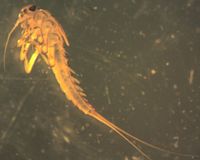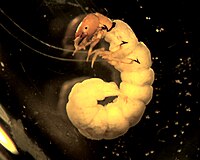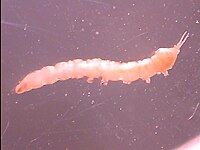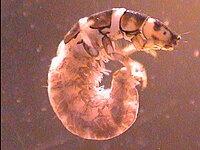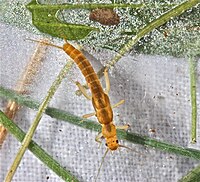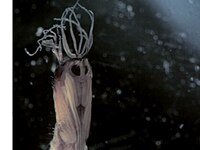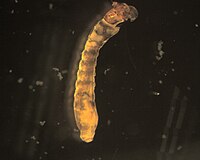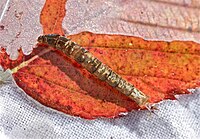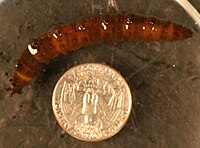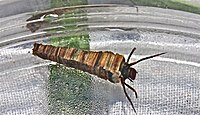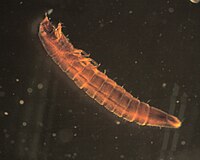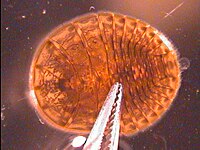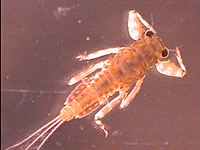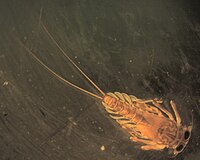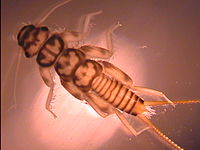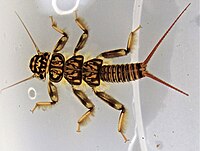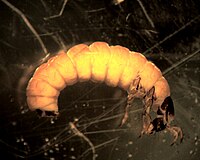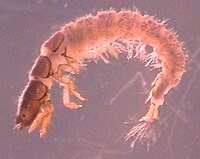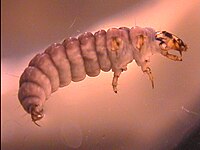Vermont EPSCoR's Streams Project; A Teacher Collaboration on WikiEducator
Openly shared content, practices, and developing resources from Vermont EPSCoR's Streams Project. Join this collaboration and make a difference!
 Walloomsac River |
|---|
|
| Stream code: | HRD_WaRv_767 |
| Basin: | Hudson River |
| State or Province: | Vermont |
| Country: | USA |
| Latitude: | 42.889503 |
| Longitude: | -73.202878 |
| School: | Mount Anthony Union High School |
The following are the most common invertebrates collected from this stream site.
Baetis
- Order
- Ephemeroptera
- Family
- Baetidae
- Genus
- Baetis
- Common name
- The Little Olive
- Tied fly
- Sawyer Pheasant Tail Nymph
This mayfly has three "tails" and a unique head shape. Its gills are oval shaped and insert dorsally. More mature nymphs have long, dark wing pads.
Image of the long, dark wing pads.
Dolophilodes
- Order
- Trichoptera
- Family
- Philopotamidae
- Genus
- Dolophilodes
Chironomidae
- Order
- Diptera
- Family
- Chironomidae
- Common name
- Nonbiting midge
- Tied fly
- Griffith's Gnat
Midge larvae tend to be the most common macroinvertebrate at our sites. As with other Diptera, there are no true jointed legs. Chironomidae do have a pair of prolegs at each end and preserved individuals tend to curl into a 'C'. Identification past family requires slide-mounted heads. We have seen philopotamid caddisflies misidentified with the chironomids and we suspect that that happens when samples are being sorted from trays. Under a microscope, six prominent legs can be seen on members of the caddisfly family Philopotamidae.
More information on Philopotamidae.
Dicranota
- Order
- Diptera
- Family
- Tipulidae
- Genus
- dicranota
Dicranota can be distinguished by the two tails and their comb feet. There are usually 5 pairs of prolegs on the abdomen with combs on them. In addition, the posterior portion of the abdomen often has a slight swelling.
Image of the prolegs.
Ceratopsyche
- Order
- Trichoptera
- Family
- Hydropsychidae
- Genus
- Ceratopsyche
Ceratopsyche has a
forked foretrochantin. The foretrochantin is the projection at the uppermost portion of the foreleg. The leg may need to be pulled away from the body to expose this feature.
Ceratopsyche have a
large pair of sclerites underneath the prosternum. Note: the large single sclerite is the prosternal plate. Biologists have gone back and forth between lumping this genus into
Hydropsyche and splitting it back out. ITIS currently lists it as a genus (Feb 2013) but we are aware of a recent paper that lumped it under
Hydropsyche.
Leuctra
- Order
- Plecoptera
- Family
- Leuctridae
- Genus
- Leuctra
This family of stonefly is fairly slender by stonefly standards. The divergent wing pads are a helpful characteristic. Leuctridae are similar in overall shape to the Capniidae; however, Leuctridae often do not have pleural folds. If they are present, they only extend from abdominal segments 1-7.
Leuctra are recognized by abdominal terga with posterior fringes of short hairs and last few segments with longer hairs.
Image of the divergent wing pads.
Diptera
- Order
- Diptera
- Tied fly
- Griffith's Gnat
Pupae from the order Diptera are typically found in small numbers at every site. These can be identified further, but we do not.
Simuliidae
- Order
- Diptera
- Family
- Simuliidae
Simuliidae appear rather like bowling pins with heads. Relatively speaking, we collect few members of this family and have we have not identified them past family at this point.
Click here for a close up image of the heads.
Hexatoma
- Order
- Diptera
- Family
- Tipulidae
- Genus
- Hexatoma
This Tipulidae can be identified by the swollen 7th abdominal segment. The swelling is bulbous and frequently as much as 2X abdominal diameter in preserved specimens.
Tipula
- Order
- Diptera
- Family
- Tipulidae
- Genus
- Tipula
This genus of Tipula is rather large as compared with other genera. Tipula larvae are generally dark brown and have creeping welts.
Brachycentrus
- Order
- Trichoptera
- Family
- Brachycentridae
- Genus
- Brachycentrus
- Common name
- The Olive Dun Caddis
- Tied fly
- Deer Hair Caddis
These larvae are typically found with their legs extended out of their case for feeding. The cases are square in cross section and made of plant materials. Brachycentrus has 2 large sclerites on the metanotum. In fresh samples (preserved for less than one week) these organisms often have a pale green tint; live specimens are a more vivid green.
Stenelmis
- Order
- Coleoptera
- Family
- Elmidae
- Genus
- Stenelmis
The larvae of
Stenelmis, as in
Ordobrevia, have a sternum on the ventral side of the pronotum. The main difference between the two genera is in the antennae the second segment is less than twice as long as the first in
Stenelmis.
The adult Stenelmis has a clear separation between the thorax and abdomen as well as a more distinctly separate head as compared to other genera.
Click here to see pictures of the sternum and
antennae-
Psephenus
- Order
- Coleoptera
- Family
- Psephenidae
- Genus
- Psephenus
The true "water penny" is commonly found in the waters sampled.
Psephenus has a rounded shape with relatively smooth edge. The
false water penny, whose edges are serrated, has a more oval appearance. The
gills on the ventral surface are found only in the true water pennies.
Another genus encountered in this family is Ectopria.
Ephemerella
- Order
- Ephemeroptera
- Family
- Ephemerellidae
- Genus
- Ephemerella
- Common name
- The Hendrickson; The Red Quill; The Hendrickson Spinner Fall
- Tied fly
- Hendrickson; Flick's Red Quill; Lunn's Particular
Mayflies in this genus have long intersegmental setae on their cerci that extend laterally and may or may not have whorls of spines at the end of each segment of their cerci. Their maxillary palps are well-developed.
Image of the intersegmental setae.
Epeorus
- Order
- Ephemeroptera
- Family
- Heptageniidae
- Genus
- Epeorus
- Common name
- The Quill Gordon
- Tied fly
- Quill Gordon
This is the only Heptageniidae genus present in this area with two tails!
Agnetina
- Order
- Plecoptera
- Family
- Perlidae
- Genus
- Agnetina
Agnetina nymphs have cylindrical, striped abdomens. Like other Plecoptera, they have 2 tails and 2 claws on each tarsus. This genus has three black dots (ocelli) on the top of the head. Click to see the
three ocelli on the dorsum of the head (3 black dots at joint with the pronotum). This stonefly is characterized by the
filamentous gills located in the "armpits". Another important feature is the paraglossae and glossae extending different lengths. The
occiput has a transverse row of evenly spaced little hairs.
Agnetina has another row of evenly spaced hairs on the posterior edge of
abdominal segment 7.
Paragnetina
- Order
- Plecoptera
- Family
- Perlidae
- Genus
- Paragnetina
Paragnetina have 3 ocelli (spots) on the back of their head. Like the other Perlidae, there are highly branched gills located on the sides of the thorax. The dorsal sides of the abdominal segments have small hairs on lateral portions but not in the center of the segment.
Glossosomatidae
- Order
- Trichoptera
- Family
- Glossosomatidae
- Common name
- saddlecase caddisfly
Larvae in this family build domed cases made of small rocks, and are often wider at segment 5. The pronotum is covered in dark, sclerotized plates, but there are either
no sclerites on the mesonotum, or the mesonotum is unsclerotized with the exception of a few patches. The anal proleg is broadly joined to segment 9; the anal claw has one or more accessory hooks. The
pronotal excision is small (approximately 1/3 anterolaterally) to accommodate the coxae.
Commonly encountered genera include Glossosoma and Agapetus.
Cheumatopsyche
- Order
- Trichoptera
- Family
- Hydropsychidae
- Genus
- Cheumatopsyche
Cheumatopsyche has a
forked foretrochantin (as does
Ceratopsyche). The foretrochantin is the projection at the uppermost portion of the front leg closest to the head. The leg may need to be pulled away from the body to expose this feature.
Cheumatopsyche have a small or inconspicuous
pair of sclerites under the prosternal plate that are difficult to see. Contrast that with the
larger pair of sclerites found on Ceratopsyche. To access sclerites, it's best to gently pull the pronotum and mesonotum in opposite directions. Note: the large single sclerite is the prosternal plate.
Cheumatopsyche have only 2 types of
hair on the abdomen: long thin plain hairs and thicker club hairs, which are narrow close to the body and widen out at the distal end. Paired sclerites on the ninth abdominal segment are notched.
Rhyacophila
- Order
- Trichoptera
- Family
- Rhyacophilidae
- Genus
- Rhyacophila
- Common name
- Green Caddis
- Tied fly
- Henryville Special or Glass Bead Caddis
In our lab,
Rhyacophila is known as the "Michelin Man" due to its large banded body. It has a very obviously checker-patterned head. It also has terrifying anal claws with large accessory hooks.
Links to images that may be useful if you have a magnifying glass or microscope:
Checker-patterned head.
Anal claws with large accessory hooks.

